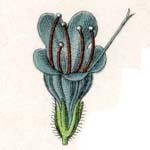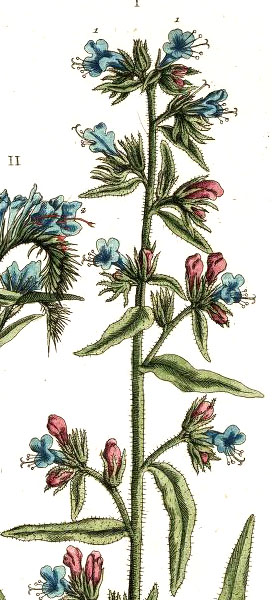
 | VIPER'S BUGLOSS
Echium vulgare L.
(Greek: echis = snake)
As
with numerous labiates (see thyme), the "pistil tongue" of this
rough-leaf plant juts far out of the pink crown tube. The dual-lobe
stigma thus reminds of the split tongue of a snake. But also the
filaments stick out of the top, hence reminding of a whole basket of
adders.
Reason enough, according to mediaeval teachings
on signs, to consider the plant as a remedy against snakebite (in the
middle ages, similarities between parts of plants and certain human
organs were recognized as a "sign from God" indicating possible
medicinal effects). This healing effect does not exist - though the
young leaves of the viper´s bugloss can be used as wild vegetables, the
root as a colorant, and, furthermore, the plant is an important feeding
plant for bees, bumble bees and butterflies.
It grows
on dry, stony ground, along paths and undeveloped sites, and has given
its name to an own plant association, the viper´s bugloss -sweet
clover-rockery.
Picture above:
Sturm, Jacob; Sturm, Johann Georg (1796): Deutschlands Flora in Abbildungen. Stuttgart. [Ausschnitt].
© Kurt Stüber's Online Library. www.biolib.de
Picture below:
Blackwell,
Elizabeth (1750-1773): Herbarium Blackwellianum emendatum et auctum
[...]. Norimbergae : Typis Io. Iosephi Fleischmanni. [Ausschnitt].
© 1995-2003 Missouri Botanical Garden, Rare Books. http://ridgwaydb.mobot.org/mobot/rarebooks/
|



